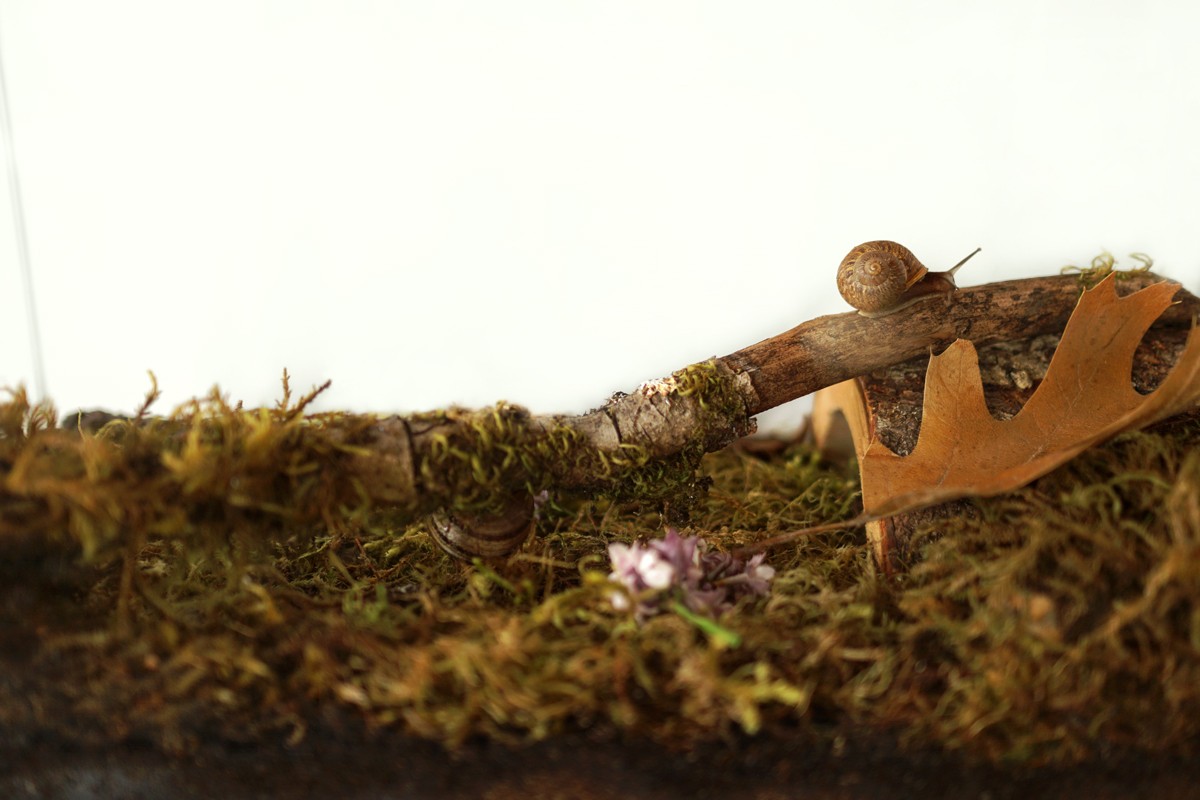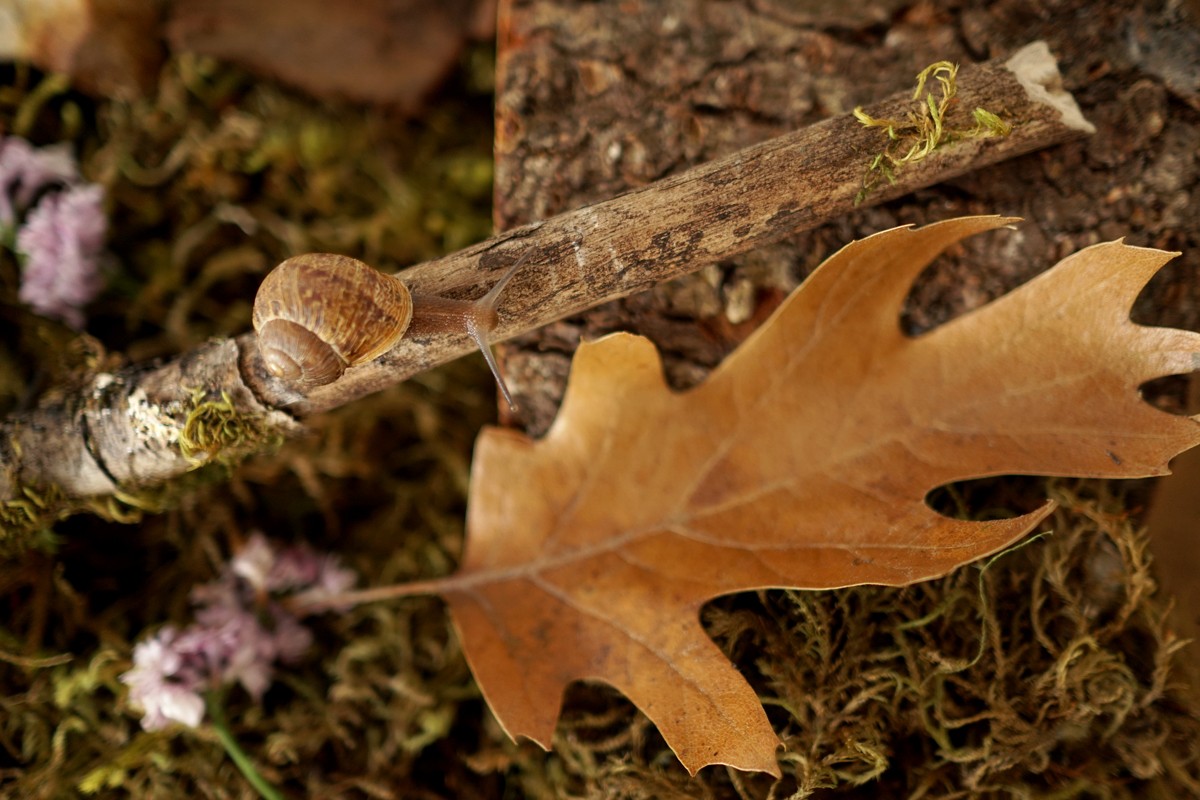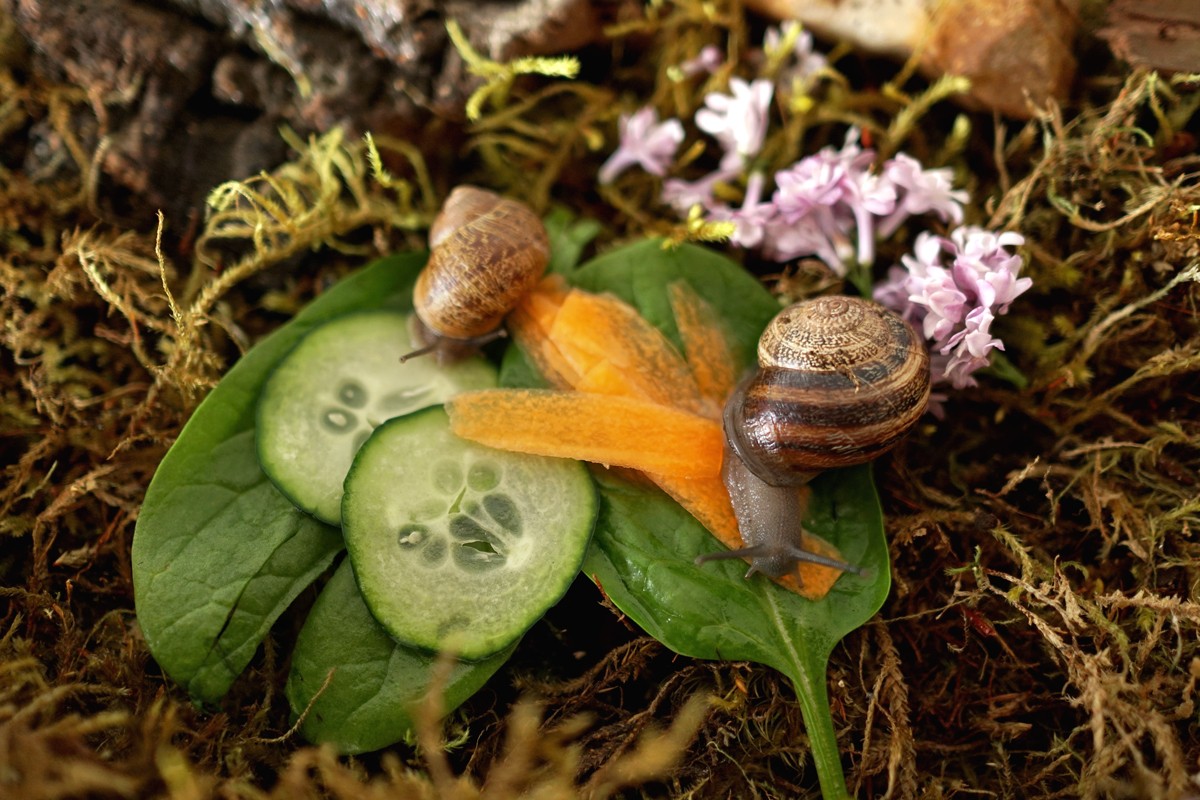Keeping a snail as a pet can be a wonderfully rewarding experience. At PETS.EDU.VN, we provide you with essential insights and practical advice for setting up a comfortable habitat and ensuring these fascinating creatures thrive. This comprehensive guide will cover everything from choosing the right terrarium to providing a balanced diet, ensuring your pet snail lives a happy and healthy life.
1. Understanding Snail Basics
Before diving into the specifics of snail care, it’s essential to understand some fundamental aspects of these creatures. Snails are mollusks, related to clams and oysters, not insects. The average lifespan of a snail is around 5 years, but they can live up to 20 years in captivity with proper care. Understanding their basic biology and needs is the first step in becoming a responsible snail owner.
1.1. Snail Biology
Snails are gastropods, meaning “stomach-foot,” and they move using a muscular foot. They have a shell that protects their soft bodies, and this shell grows with them throughout their life. Snails also have sensory tentacles on their head used for smelling and feeling their environment. According to a study published in the “Journal of Molluscan Studies,” snails exhibit complex behaviors and preferences, making them more engaging pets than one might initially think.
1.2. Snail Behavior
Snails are primarily nocturnal, meaning they are most active at night. They enjoy company, so keeping multiple snails together is often recommended. Snails also have unique behaviors, such as burrowing into the substrate and exploring their environment. These behaviors can be fascinating to observe and provide insight into the snail’s well-being.
1.3. Different Snail Species
There are various species of snails that can be kept as pets, each with its unique characteristics and care requirements. The most common types include:
- Garden Snail (Cornu aspersum): This is one of the most commonly kept pet snails. They are hardy and adaptable, making them a great choice for beginners.
- Giant African Land Snail (Achatina fulica): Known for their large size, these snails require a bit more space and care but are fascinating to observe.
- Milk Snail (Otala lactea): These snails are smaller and have a milky white shell. They are native to the Mediterranean region and prefer slightly drier conditions.
- grove snail (Cepaea nemoralis): This snail is easy to take care of and is an awesome pet!
Understanding the specific needs of your chosen species is crucial for their health and happiness. More detailed information on snail species can be found on reputable websites such as the Invertebrate Anatomy OnLine.
2. Setting Up the Perfect Snail Habitat
Creating the right habitat is crucial for the well-being of your pet snail. The terrarium should mimic their natural environment as closely as possible, providing the right temperature, humidity, and substrate.
2.1. Choosing the Right Terrarium
The size of the terrarium depends on how many snails you plan to keep. A minimum of 5 gallons is recommended for a couple of snails, but a 10-gallon tank is ideal if you want to add more. The general rule is 1 gallon per snail. The terrarium can be made of glass or plastic, but it should have a tight-fitting lid to prevent escapes and maintain humidity.
Alt text: Glass terrarium setup with soil, moss, and decorations, creating a humid environment for pet snails.
2.2. Substrate Selection
The substrate is the material that lines the bottom of the terrarium. It should be pesticide-free, chemical-free, and fertilizer-free. Avoid using potting soil, as it may contain harmful chemicals. Snails like to burrow, so avoid using sand, pebbles, or gravel. Recommended substrates include:
- Sterilized Soil: Specifically sold for pets and terrariums.
- Coconut Coir: A natural and sustainable option that retains moisture well.
- Sphagnum Moss: Helps maintain humidity and provides a soft padding for snails.
Peat moss is not recommended because it is too acidic. According to a study in “Applied Soil Ecology,” the substrate’s pH level significantly impacts snail health and activity.
2.3. Decorating the Habitat
Snails love to climb and explore, so adding decorations to the terrarium is essential. Suitable decorations include:
- Sticks and Branches: Provide climbing opportunities.
- Bark Pieces: Offer hiding places.
- Leaves: Add natural elements to the habitat.
- Hollowed-Out Logs: Create caves for snails to retreat to.
- Live Plants: Ensure they are non-toxic to snails.
Avoid using rocks, as snails may fall and break their shells. “Journal of Animal Behavior” highlights the importance of enrichment in snail habitats to promote natural behaviors and reduce stress.
Alt text: Snail terrarium featuring climbing sticks and various leaf types, providing enrichment and climbing opportunities for snails.
2.4. Maintaining Temperature and Humidity
Snails thrive in a humid environment. The ideal humidity level is between 70% and 80%. Use a hygrometer to monitor the humidity level and mist the terrarium with filtered water as needed. The temperature should be kept between 65°F and 75°F (18°C to 24°C). Avoid placing the terrarium in direct sunlight, as this can cause the temperature to rise too high.
2.5. Cleaning the Habitat
Regular cleaning is essential for maintaining a healthy environment. Remove any waste and uneaten food regularly. A thorough cleaning should be done once or twice a month, involving replacing the substrate and washing the terrarium with warm, soapy water. Always rinse thoroughly to remove any soap residue.
3. Feeding Your Pet Snail
A balanced diet is crucial for the health and well-being of your pet snail. Garden snails are herbivores and require a variety of fresh raw vegetables, fruits, calcium, and protein.
3.1. What to Feed Your Snail
Snails enjoy a wide variety of foods, including:
- Leafy Greens: Such as lettuce, kale, and spinach.
- Carrots: Grated or sliced.
- Cucumber: A favorite among many snails.
- Apple: In small pieces.
- Flowers: Edible flowers like nasturtiums and pansies.
- Dandelion Leaves: A nutritious and natural food source.
- Squash: Provides essential nutrients.
- Sweet Potato: Cooked and mashed.
- Zucchini: Sliced or grated.
- Berries: Strawberries, blueberries, and raspberries.
Avoid acidic fruits like citrus fruits, as they can harm snails. The “Journal of Invertebrate Pathology” notes that a varied diet enhances snails’ immune response and overall health.
3.2. Calcium Source
Calcium is essential for the growth and maintenance of a snail’s shell. Provide a constant source of calcium in the terrarium. Good sources of calcium include:
- Cuttlebone: Available at most pet stores.
- Eggshells: Cleaned and crushed.
- Calcium Carbonate Powder: Can be sprinkled on their food.
3.3. Protein Source
Protein is essential for snail growth and reproduction. Provide a protein source once or twice a week. Good sources of protein include:
- Fish Flakes: A small amount sprinkled on their food.
- Dried Shrimp: Rehydrated and chopped.
- Mealworms: As an occasional treat.
3.4. Feeding Schedule
Feed your snails daily. Remove any uneaten food to prevent mold growth. Provide a shallow dish of filtered water for them to drink or play in. Always clean the food before feeding it to remove any traces of harmful substances.
3.5. Foods to Avoid
Certain foods can be harmful to snails and should be avoided:
- Salty Foods: Salt can dehydrate and kill snails.
- Acidic Foods: Citrus fruits can damage their shells.
- Processed Foods: Contain chemicals and preservatives that are harmful to snails.
- Toxic Plants: Some plants are poisonous to snails.
4. Handling Your Pet Snail Safely
Handling your pet snail can be a fun and interactive experience. However, it’s essential to handle them safely to avoid harming them or exposing yourself to pathogens.
4.1. Washing Your Hands
Always wash your hands thoroughly before and after handling snails. This prevents the spread of pathogens and protects both you and your snail.
4.2. Gentle Handling
Handle snails gently to avoid damaging their shells. Pick them up by gently sliding your finger underneath their foot. Avoid pulling them off surfaces, as this can injure them.
4.3. Supervise Children
Supervise children when they handle snails. Teach them to be gentle and to wash their hands thoroughly afterwards.
4.4. Avoid Contact with Mouth or Eyes
Avoid touching your mouth or eyes after handling snails. This reduces the risk of exposure to pathogens.
4.5. Signs of Stress
Watch for signs of stress in your snail, such as:
- Excessive Mucus Production: Indicates irritation.
- Retracted Body: Suggests fear or discomfort.
- Lack of Activity: May indicate illness or stress.
If you notice these signs, reduce handling and ensure the snail’s environment is optimal.
5. Common Health Issues and Prevention
Like any pet, snails can be susceptible to certain health issues. Understanding these issues and how to prevent them is crucial for ensuring your snail’s well-being.
5.1. Shell Problems
Shell problems are common in pet snails and can be caused by a lack of calcium, poor diet, or improper handling. Signs of shell problems include:
- Thin or Brittle Shell: Indicates a calcium deficiency.
- Cracks or Breaks: Can be caused by trauma or poor shell quality.
- Discoloration: May indicate a fungal infection.
To prevent shell problems, provide a constant source of calcium, feed a balanced diet, and handle snails gently.
5.2. Parasites
Snails can be affected by parasites, such as mites and nematodes. Signs of a parasitic infection include:
- Lethargy: Reduced activity.
- Loss of Appetite: Refusal to eat.
- Visible Parasites: Small mites crawling on the snail’s body.
To prevent parasitic infections, use sterilized substrate, quarantine new snails, and maintain a clean habitat.
5.3. Fungal Infections
Fungal infections can occur in snails, especially in humid environments. Signs of a fungal infection include:
- White or Fuzzy Growth: On the snail’s body or shell.
- Lethargy: Reduced activity.
- Loss of Appetite: Refusal to eat.
To prevent fungal infections, maintain a clean and well-ventilated habitat and avoid over-misting.
5.4. Mantle Collapse
Mantle collapse is a serious condition where the snail’s mantle (the tissue that lines the shell) detaches from the shell. This can be caused by stress, dehydration, or poor diet. Signs of mantle collapse include:
- Visible Separation: Between the mantle and the shell.
- Lethargy: Reduced activity.
- Loss of Appetite: Refusal to eat.
Mantle collapse requires immediate veterinary attention. To prevent it, provide a stress-free environment, maintain proper humidity, and feed a balanced diet.
5.5. Preventing Health Issues
Preventing health issues in snails involves:
- Providing a Proper Habitat: Maintain the right temperature, humidity, and substrate.
- Feeding a Balanced Diet: Ensure snails receive adequate nutrition.
- Handling Snails Safely: Avoid damaging their shells.
- Maintaining a Clean Habitat: Regular cleaning prevents the buildup of harmful bacteria and parasites.
- Quarantining New Snails: Prevents the spread of diseases.
6. Breeding Snails
Breeding snails can be a rewarding experience, but it’s essential to be prepared for the responsibilities that come with it. Snails are prolific breeders, and you may end up with more snails than you can care for.
6.1. Creating Breeding Conditions
To encourage breeding, maintain optimal conditions in the terrarium. Ensure the temperature and humidity are within the ideal range, and provide a balanced diet.
6.2. Egg Laying
Snails lay their eggs in the substrate. The eggs are small, round, and white. They are usually laid in clusters.
6.3. Incubation
The eggs will hatch in a few weeks, depending on the temperature and humidity. Keep the substrate moist during incubation.
6.4. Caring for Hatchlings
Hatchlings are small and fragile. Provide them with a shallow dish of water and a constant source of calcium. Feed them finely grated vegetables and fruits.
6.5. Responsible Breeding
Consider the responsibilities of breeding snails before attempting it. Ensure you have enough space and resources to care for the hatchlings. If you cannot care for them, consider giving them away to other snail enthusiasts or contacting a local reptile rescue organization.
7. The Joys of Keeping Snails as Pets
Keeping snails as pets can be a surprisingly rewarding experience. They are low-maintenance, quiet, and fascinating to observe.
7.1. Educational Value
Snails can be educational for children and adults alike. They provide an opportunity to learn about biology, ecology, and responsible pet ownership.
7.2. Low Maintenance
Snails are relatively low-maintenance pets. They don’t require a lot of space, exercise, or attention.
7.3. Quiet and Peaceful
Snails are quiet pets that won’t disturb your home. They can be a calming presence in a busy household.
7.4. Fascinating to Observe
Snails have unique behaviors that can be fascinating to observe. Watching them eat, climb, and interact with their environment can be surprisingly engaging.
7.5. Therapeutic Benefits
Some people find keeping snails as pets to be therapeutic. Caring for these gentle creatures can be a relaxing and rewarding experience.
Alt text: Snails feeding on a variety of fresh vegetables within their terrarium, illustrating their herbivorous diet.
8. Advanced Snail Care Tips
For those looking to take their snail care to the next level, here are some advanced tips to ensure your snails thrive:
8.1. Naturalistic Terrarium Design
Creating a naturalistic terrarium involves replicating the snail’s natural habitat as closely as possible. This includes:
- Layered Substrate: Use different layers of substrate to mimic the forest floor, including leaf litter, decaying wood, and soil.
- Live Plants: Incorporate live plants that are native to the snail’s natural habitat.
- Natural Lighting: Use LED lights to simulate natural sunlight.
- Water Features: Add a small water dish or fountain to increase humidity and provide a source of water.
8.2. Nutritional Supplements
While a balanced diet is essential, nutritional supplements can help ensure your snails are getting all the nutrients they need. Consider adding:
- Vitamin Supplements: Provide essential vitamins for growth and health.
- Mineral Supplements: Ensure adequate mineral intake.
- Probiotics: Promote healthy gut bacteria.
8.3. Enrichment Activities
Enrichment activities can help stimulate snails and prevent boredom. Consider:
- Rotating Decorations: Change the decorations in the terrarium regularly to provide new climbing and hiding opportunities.
- Food Puzzles: Use food puzzles to encourage snails to forage for food.
- Social Interaction: Keep multiple snails together to promote social interaction.
8.4. Advanced Monitoring
Monitor your snails closely for any signs of illness or stress. This includes:
- Regular Weighing: Track your snail’s weight to detect any changes.
- Shell Inspection: Examine the shell for any signs of damage or discoloration.
- Behavioral Observation: Observe your snail’s behavior for any signs of lethargy or loss of appetite.
8.5. Veterinary Care
Consult with a veterinarian experienced in invertebrate care for any health concerns. Regular check-ups can help detect and treat health issues early.
9. Snail Care Checklist
To help you stay organized, here’s a checklist of essential snail care tasks:
| Task | Frequency | Description |
|---|---|---|
| Feeding | Daily | Provide fresh vegetables, fruits, calcium, and protein. |
| Misting | Daily | Mist the terrarium with filtered water to maintain humidity. |
| Waste Removal | Daily | Remove any waste and uneaten food. |
| Water Dish Cleaning | Daily | Clean and refill the water dish. |
| Substrate Check | Weekly | Check the substrate for moisture and cleanliness. |
| Terrarium Cleaning | Monthly | Replace the substrate and wash the terrarium with warm, soapy water. |
| Health Check | Weekly | Check for any signs of illness or stress. |
| Calcium Source Replenish | As Needed | Replace cuttlebone or add calcium carbonate powder. |
| Temperature & Humidity | Daily | Ensure the terrarium temperature and humidity are within the ideal range. |
| Enrichment Activities | Weekly | Rotate decorations or provide food puzzles. |



10. Frequently Asked Questions About Snail Care
Here are some frequently asked questions about keeping snails as pets:
10.1. Are snails good pets for beginners?
Yes, snails are great pets for beginners due to their low maintenance needs and ease of care.
10.2. What do snails eat?
Snails eat a variety of fresh vegetables, fruits, calcium sources, and protein sources.
10.3. How big of a tank do I need for a snail?
A minimum of 5 gallons is recommended for a couple of snails, but a 10-gallon tank is ideal for more snails.
10.4. How often do I need to clean a snail tank?
You should remove waste and uneaten food daily and do a thorough cleaning once or twice a month.
10.5. Do snails need light?
Snails don’t need special lighting, but LED lights can simulate natural sunlight in their terrarium.
10.6. How do I handle a snail safely?
Always wash your hands before and after handling snails, and handle them gently to avoid damaging their shells.
10.7. What is the ideal temperature and humidity for snails?
The ideal temperature is between 65°F and 75°F (18°C to 24°C), and the ideal humidity is between 70% and 80%.
10.8. How long do snails live?
Snails can live up to 20 years in captivity with proper care, but their average lifespan is around 5 years.
10.9. What are some common health issues in snails?
Common health issues include shell problems, parasites, fungal infections, and mantle collapse.
10.10. Can I keep different species of snails together?
It’s generally not recommended to keep different species of snails together, as they may have different care requirements and can potentially spread diseases.
Conclusion: Start Your Snail-Keeping Adventure Today
Keeping snails as pets can be a fun, educational, and rewarding experience. By providing the right habitat, diet, and care, you can ensure your snails live a long and healthy life. Remember to consult reputable sources like PETS.EDU.VN for reliable information and guidance.
At PETS.EDU.VN, we are dedicated to providing comprehensive and reliable information to help you care for your pets. We understand the challenges pet owners face in finding trustworthy advice and resources. That’s why we offer a wealth of in-depth articles, expert tips, and personalized support to address your specific concerns.
Do you want to learn more about creating the best possible environment for your pet snail or explore other fascinating pets? Visit PETS.EDU.VN today! Our extensive library of articles and resources is designed to help you navigate the world of pet care with confidence. Whether you need advice on nutrition, health, or behavior, PETS.EDU.VN is your go-to source for all things pet-related. Contact us at 789 Paw Lane, Petville, CA 91234, United States, or via Whatsapp at +1 555-987-6543. Let pets.edu.vn be your trusted partner in providing the best care for your beloved pets.
